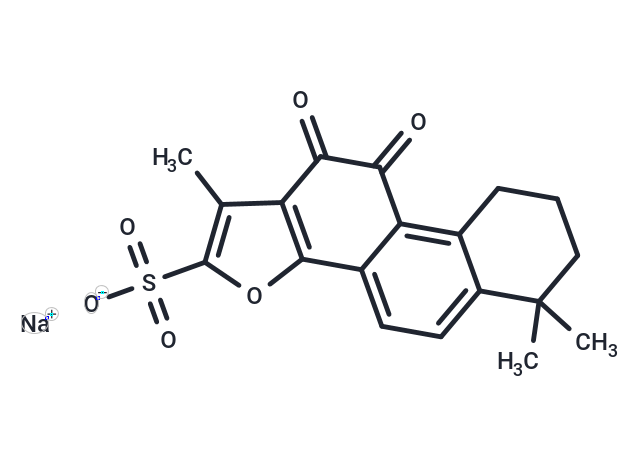Shopping Cart
- Remove All
 Your shopping cart is currently empty
Your shopping cart is currently empty

Tanshinone IIA sulfonate sodium (Tanshinone IIA sodium sulfonate) is a water-soluble derivative of tanshinone IIA extracted from Savia miltiorrhiza; a potent negative allosteric modulator of the human purinergic receptor P2X7. Tanshinone IIA sulfonate sodium (12.5 μM) inhibits hypoxia-induced PKG and PPAR-γ downregulation in PASMCs and distal pulmonary arteries of rats.

| Pack Size | Price | Availability | Quantity |
|---|---|---|---|
| 10 mg | $39 | In Stock | |
| 25 mg | $64 | In Stock | |
| 50 mg | $93 | In Stock | |
| 100 mg | $137 | In Stock | |
| 500 mg | $342 | In Stock |
| Description | Tanshinone IIA sulfonate sodium (Tanshinone IIA sodium sulfonate) is a water-soluble derivative of tanshinone IIA extracted from Savia miltiorrhiza; a potent negative allosteric modulator of the human purinergic receptor P2X7. Tanshinone IIA sulfonate sodium (12.5 μM) inhibits hypoxia-induced PKG and PPAR-γ downregulation in PASMCs and distal pulmonary arteries of rats. |
| Targets&IC50 | CYP3A4:6.377 μM |
| In vitro | Sodium Tanshinone IIA sulfonate (12.5 μM) effectively inhibits hypoxia-induced downregulation of PKG and PPAR-γ in PASMCs and distal pulmonary arteries of rats, preserving pulmonary vascular function. It prevents TRPC1 and TRPC6 reduction in hypoxic PASMCs, reversible upon PKG or PPAR-γ knockdown, implicating the PKG-PPAR-γ axis in mitigating PASMCs' proliferative response under hypoxia. A PPAR-γ agonist enhances the compound's maintenance of basal calcium levels and store-operated calcium entry (SOCE) in PASMCs. Sodium Tanshinone IIA sulfonate dose-dependently inhibits CYP3A4 activity in human liver microsomes (HLMs) and the CYP3A4 isoform with minimal impact on other CYP enzymes, suggesting a specific interaction with the CYP3A4 pathway. Kinetic parameters for CYP3A4 inhibition are detailed for both HLMs and the CYP3A4 isoform. Due to its significant CYP3A4 inhibitory effect, it has potential for drug-drug interactions with other CYP3A4 substrates. |
| In vivo | Sodium Tanshinone IIA sulfonate administered at dosages of 10 mg/kg and 20 mg/kg, in conjunction with Donepezil, effectively reduces escape latency, enhances the number of times subjects crossed the original platform location, and extends the duration spent in the target quadrant in experimental settings. This compound notably diminishes acetylcholinesterase (AChE) activity while boosting choline acetyltransferase (ChAT) activity within the hippocampus and cortex of SCOP-treated mice, alongside increasing superoxide dismutase (SOD) activity and reducing malondialdehyde (MDA) and reactive oxygen species (ROS) levels in the same regions. At a preventive dosage of 30 mg/kg/day, Sodium Tanshinone IIA sulfonate mitigates the characteristic alterations induced by hypoxia in a chronic hypoxia PH rat model. Moreover, when administered intraperitoneally at dosages of 20, 10, and 5 mg/kg, it effectively prevents peritoneal adhesion without impeding anastomotic healing in rats, demonstrating increased peritoneal lavage fluid tPA activity and tPA/PAI-1 ratio, alongside decreased TGF-β1 and collagen I expressions in ischemic tissues. |
| Alias | Tanshinone IIA sulfonate, Tanshinone IIA sodium sulfonate, Sodium Tanshinone IIA sulfonate |
| Molecular Weight | 396.39 |
| Formula | C19H17O6S·Na |
| Cas No. | 69659-80-9 |
| Smiles | [Na+].Cc1c2c(oc1S([O-])(=O)=O)-c1ccc3c(CCCC3(C)C)c1C(=O)C2=O |
| Relative Density. | no data available |
| Storage | Powder: -20°C for 3 years | Shipping with blue ice. | |||||||||||||||||||||||||||||||||||
| Solubility Information | DMSO: 50 mg/mL (126.14 mM), The compound is unstable in solution. Please use soon. | |||||||||||||||||||||||||||||||||||
Solution Preparation Table | ||||||||||||||||||||||||||||||||||||
DMSO
| ||||||||||||||||||||||||||||||||||||

Copyright © 2015-2025 TargetMol Chemicals Inc. All Rights Reserved.